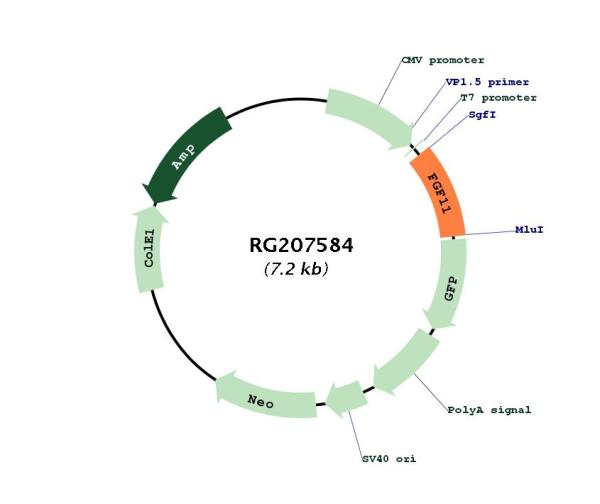FGF11 (NM_004112) Human Tagged ORF Clone
CAT#: RG207584
- TrueORF®
FGF11 (tGFP-tagged) - Human fibroblast growth factor 11 (FGF11)
ORF Plasmid: DDK
Lentiviral Particles: DDK w/ Puro mGFP w/ Puro
AAV Particle: DDK
"NM_004112" in other vectors (4)
Specifications
| Product Data | |
| Type | Human Tagged ORF Clone |
| Tag | TurboGFP |
| Symbol | FGF11 |
| Synonyms | FGF-11; FHF-3; FHF3 |
| Vector | pCMV6-AC-GFP |
| E. coli Selection | Ampicillin (100 ug/mL) |
| Mammalian Cell Selection | Neomycin |
| Sequence Data |
>RG207584 representing NM_004112
Red=Cloning site Blue=ORF Green=Tags(s) TTTTGTAATACGACTCACTATAGGGCGGCCGGGAATTCGTCGACTGGATCCGGTACCGAGGAGATCTGCC GCCGCGATCGCC ATGGCGGCGCTGGCCAGTAGCCTGATCCGGCAGAAGCGGGAGGTCCGCGAGCCCGGGGGCAGCCGGCCGG TGTCGGCGCAGCGGCGCGTGTGTCCCCGCGGCACCAAGTCCCTTTGCCAGAAGCAGCTCCTCATCCTGCT GTCCAAGGTGCGACTGTGCGGGGGGCGGCCCGCGCGGCCGGACCGCGGCCCGGAGCCTCAGCTCAAAGGC ATCGTCACCAAACTGTTCTGCCGCCAGGGTTTCTACCTCCAGGCGAATCCCGACGGAAGCATCCAGGGCA CCCCAGAGGATACCAGCTCCTTCACCCACTTCAACCTGATCCCTGTGGGCCTCCGTGTGGTCACCATCCA GAGCGCCAAGCTGGGTCACTACATGGCCATGAATGCTGAGGGACTGCTCTACAGTTCGCCGCATTTCACA GCTGAGTGTCGCTTTAAGGAGTGTGTCTTTGAGAATTACTACGTCCTGTACGCCTCTGCTCTCTACCGCC AGCGTCGTTCTGGCCGGGCCTGGTACCTCGGCCTGGACAAGGAGGGCCAGGTCATGAAGGGAAACCGAGT TAAGAAGACCAAGGCAGCTGCCCACTTTCTGCCCAAGCTCCTGGAGGTGGCCATGTACCAGGAGCCTTCT CTCCACAGTGTCCCCGAGGCCTCCCCTTCCAGTCCCCCTGCCCCC ACGCGTACGCGGCCGCTCGAG - GFP Tag - GTTTAA >RG207584 representing NM_004112
Red=Cloning site Green=Tags(s) MAALASSLIRQKREVREPGGSRPVSAQRRVCPRGTKSLCQKQLLILLSKVRLCGGRPARPDRGPEPQLKG IVTKLFCRQGFYLQANPDGSIQGTPEDTSSFTHFNLIPVGLRVVTIQSAKLGHYMAMNAEGLLYSSPHFT AECRFKECVFENYYVLYASALYRQRRSGRAWYLGLDKEGQVMKGNRVKKTKAAAHFLPKLLEVAMYQEPS LHSVPEASPSSPPAP TRTRPLE - GFP Tag - V |
| Chromatograms |
CHROMATOGRAMS
 Sequencher program is needed, download here. |
| Restriction Sites |
SgfI-MluI
Cloning Scheme for this gene
Plasmid Map

|
| ACCN | NM_004112 |
| ORF Size | 675 bp |
| OTI Disclaimer | The molecular sequence of this clone aligns with the gene accession number as a point of reference only. However, individual transcript sequences of the same gene can differ through naturally occurring variations (e.g. polymorphisms), each with its own valid existence. This clone is substantially in agreement with the reference, but a complete review of all prevailing variants is recommended prior to use. More info |
| OTI Annotation | This clone was engineered to express the complete ORF with an expression tag. Expression varies depending on the nature of the gene. |
| Product Components | The ORF clone is ion-exchange column purified and shipped in a 2D barcoded Matrix tube containing 10ug of transfection-ready, dried plasmid DNA (reconstitute with 100 ul of water). |
| Reconstitution | 1. Centrifuge at 5,000xg for 5min. 2. Carefully open the tube and add 100ul of sterile water to dissolve the DNA. 3. Close the tube and incubate for 10 minutes at room temperature. 4. Briefly vortex the tube and then do a quick spin (less than 5000xg) to concentrate the liquid at the bottom. 5. Store the suspended plasmid at -20°C. The DNA is stable for at least one year from date of shipping when stored at -20°C. |
| Reference Data | |
| RefSeq | NM_004112.4 |
| RefSeq Size | 2763 bp |
| RefSeq ORF | 678 bp |
| Locus ID | 2256 |
| UniProt ID | Q92914 |
| Cytogenetics | 17p13.1 |
| Domains | FGF |
| Protein Families | Secreted Protein |
| Protein Pathways | MAPK signaling pathway, Melanoma, Pathways in cancer, Regulation of actin cytoskeleton |
| Gene Summary | The protein encoded by this gene is a member of the fibroblast growth factor (FGF) family. FGF family members possess broad mitogenic and cell survival activities, and are involved in a variety of biological processes, including embryonic development, cell growth, morphogenesis, tissue repair, tumor growth and invasion. The function of this gene has not yet been determined. The expression pattern of the mouse homolog implies a role in nervous system development. Alternative splicing results in multiple transcript variants. [provided by RefSeq, Jan 2015] |
Documents
| Product Manuals |
| FAQs |
| SDS |
Resources
Other Versions
| SKU | Description | Size | Price |
|---|---|---|---|
| RC207584 | FGF11 (Myc-DDK-tagged)-Human fibroblast growth factor 11 (FGF11) |
USD 300.00 |
|
| RC207584L3 | Lenti ORF clone of Human fibroblast growth factor 11 (FGF11), Myc-DDK-tagged |
USD 600.00 |
|
| RC207584L4 | Lenti ORF clone of Human fibroblast growth factor 11 (FGF11), mGFP tagged |
USD 600.00 |
|
| SC128241 | FGF11 (untagged)-Human fibroblast growth factor 11 (FGF11) |
USD 300.00 |
{0} Product Review(s)
Be the first one to submit a review






























































































































































































































































 Germany
Germany
 Japan
Japan
 United Kingdom
United Kingdom
 China
China

